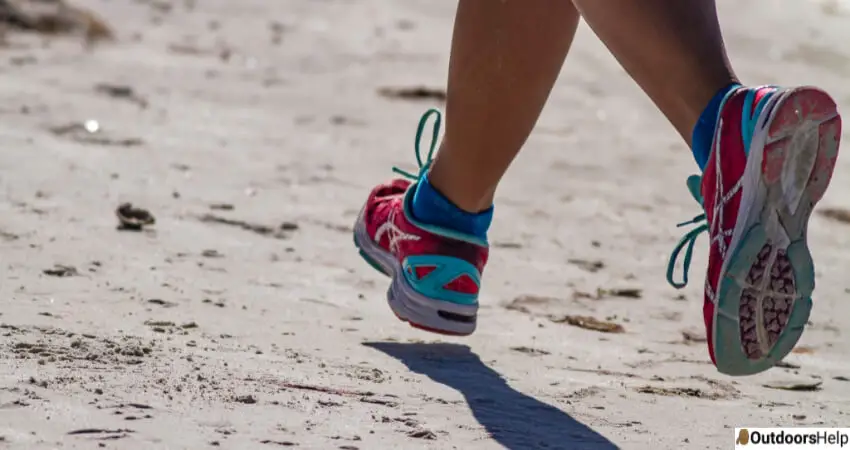Many runners get blisters after switching to new shoes, doing long runs, or running without socks. If you are running long distances, you need a good pair of socks to keep your feet dry and comfortable because the rubbing from socks made from the wrong type of material may leave your feet raw. A good pair of running socks is as important as an excellent running shoe. Running socks are designed to prevent blisters, avoid too much moisture and keep your feet happy. This is why running socks are pretty expensive compared to other generic athletic socks.
Why Do Running Cause Blisters?
Blisters are common, but they might be more common than usual if a runner doesn’t wear the right running socks. Blisters on the feet can be caused by friction between your skin and the socks, insole, or shoes. This friction makes the top layer of your skin separates from the layer below it and creates a pocket filled with fluid.
Being exposed to excessive moisture due to sweaty feet and wet conditions can soften the skin and make it more susceptible to friction and blisters. If you tie your shoes too tight or wear too-small shoes, you may also get blisters. Moreover, big shoes that allow too much movement of the feet can also cause the blister problem.
Materials Best Suited For Running Socks
When choosing running socks, it is essential to consider the material. 100% cotton socks are not suitable for running since cotton remains wet for long when in contact with moisture. When the feet sweat, that moisture will not move away from the skin, making your feet cold during winter. In the summer, running with cotton socks increases the risk of getting blisters due to moisture.
If you are on the market for running socks, you should look for synthetic materials like polyester and acrylic since these fibers will wick the moisture away from your skin surface. These materials are mainly used to make running shirts. The fabric should be breathable and anti-chafing.
If you are running during winter, go for modern wool blends. The socks are different from old-school wool socks manufactured with itch-less wool, which cannot irritate the skin. Moreover, the wool blends socks can be washed and dried in a washing machine. The advantage of buying wool socks is that it has its form of moisture management, which works well for many runners. There are also thin wool socks perfect for the summer as they are light.
Features Of The Best Running Socks
Seamless
Running socks should keep your feet dry and comfortable; hence, you should buy those with seamless construction to reduce the risk of chaffing. Socks with seams bring discomfort to your toes when running.
Thickness
The socks’ thickness depends on your personal preference. Both thin and thick ones have their advantages and disadvantages. Before you buy a pair of socks, you should try them on with your shoes to see if they affect your running shoes’ effectiveness.
Compression
Most running socks are designed in a way that gently compresses your muscles to enhance blood circulation, reduce tiredness and boost your recovery time so you can keep running for long and further. There are varieties of compression running socks ranging from knee-length for covering your calves to short ankle-length socks for the feet.
Feet Protection
Your running socks should have extra padding across the toes, heel, and ball of the feet to help reduce shock and protect the high-impact areas from getting blisters.
Ankle Support
Buying comfortable socks made from the appropriate material will grip the ankle and provide extra support, making you comfortable when running.
Waterproof
Sometimes you may want to run in the rain, which is quite relaxing. If you have the proper running attire, it will protect you from slipping and getting cold. Your running socks should be designed in a way to keep you dry and warm during the rainy days.
Odor Repellent
Running socks should repel odor by keeping your feet cool and dry. As long as you wash your socks after a run, they will remain fresh due to the odor repellent property.
Anti-Blister Technology
Runners dread blisters as they can be very painful and uncomfortable, especially during long runs. Many running socks have two layers to prevent the runner from getting blisters as they reduce the potentials for friction when the layers move against each other instead of against the skin. The only disadvantage of buying anti-blister socks is that they do not have proper ventilation and aren’t well breathable, and may cause your feet to overheat.
How To Treat A Blister During A Run
In case you get a blister before buying the right pair of running socks, you can treat it by securely covering the blister with a bandage for extra protection if you need to continue running. Sometimes the blister may stop you from running because of the pain, but other times, you can treat it by draining it, leaving the skin intact, and getting back to your race.
What Other Ways Can You Prevent Blisters When Running?
Apart from finding good socks, you can prevent blisters by:
Getting A Suitable Shoe Fit: All runners’ feet swell during the activity. Therefore, you should invest in a shoe that’s at least half of a size bigger than your regular shoes. Ensure that your toe box has enough room.
Buy Cushioned Insoles: A cushioned insole can lessen the chance of getting a blister by 25%. Cushioned insoles improve a runner’s comfort too.
Avoid Removing Your Calluses: You should advise your nail technician not to remove them during pedicure as they serve as blister protection for the feet. Removing the calluses puts you at more risk of getting blisters.
Conclusion
Buying a good pair of running socks can help prevent blister formation. If you desire to improve your running sport while avoiding blisters, you should consider ditching your cotton socks and going for a pair that’s specifically designed for the task.

